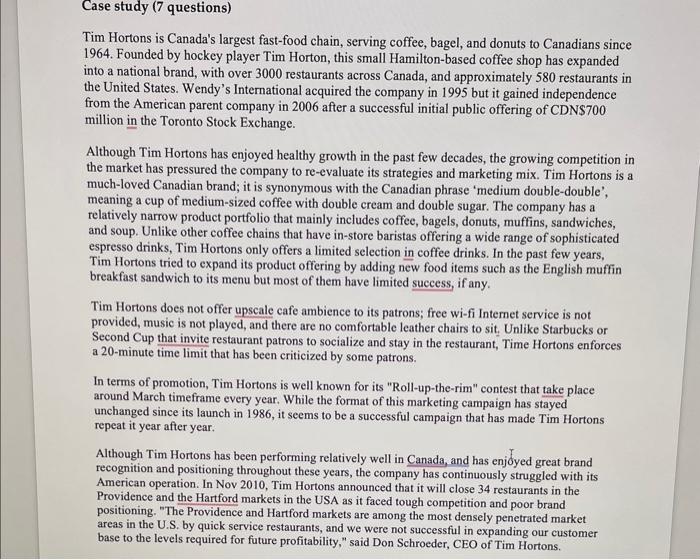Q4: As suggested in the case, Tim Hortons is a much-loved Canadian brand. Please explain why that's the case through a discussion of its Marketing Mix (4Ps). [2 marks] Tim Hortons is Canada's largest fast-food chain, serving coffee, bagel, and donuts to Canadians since 1964. Founded by hockey player Tim Horton, this small Hamilton-based coffee shop has expanded into a national brand, with over 3000 restaurants across Canada, and approximately 580 restaurants in the United States. Wendy's International acquired the company in 1995 but it gained independence from the American parent company in 2006 after a successful initial public offering of CDN\$700 million in the Toronto Stock Exchange. Although Tim Hortons has enjoyed healthy growth in the past few decades, the growing competition in the market has pressured the company to re-evaluate its strategies and marketing mix. Tim Hortons is a much-loved Canadian brand; it is synonymous with the Canadian phrase 'medium double-double', meaning a cup of medium-sized coffee with double cream and double sugar. The company has a relatively narrow product portfolio that mainly includes coffee, bagels, donuts, muffins, sandwiches, and soup. Unlike other coffee chains that have in-store baristas offering a wide range of sophisticated espresso drinks, Tim Hortons only offers a limited selection in coffee drinks. In the past few years, Tim Hortons tried to expand its product offering by adding new food items such as the English muffin breakfast sandwich to its menu but most of them have limited success, if any. Tim Hortons does not offer upscale cafe ambience to its patrons; free wi-fi Internet service is not provided, music is not played, and there are no comfortable leather chairs to sit. Unlike Starbucks or Second Cup that invite restaurant patrons to socialize and stay in the restaurant, Time Hortons enforces a 20 -minute time limit that has been eriticized by some patrons. In terms of promotion, Tim Hortons is well known for its "Roll-up-the-rim" contest that take place around March timeframe every year. While the format of this marketing campaign has stayed unchanged since its launch in 1986 , it seems to be a successful campaign that has made Tim Hortons repeat it year after year. Although Tim Hortons has been performing relatively well in Canada, and has enjoyed great brand recognition and positioning throughout these years, the company has continuously struggled with its American operation. In Nov 2010, Tim Hortons announced that it will close 34 restaurants in the Providence and the Hartford markets in the USA as it faced tough competition and poor brand positioning. "The Providence and Hartford markets are among the most densely penetrated market areas in the U.S. by quick service restaurants, and we were not successful in expanding our customer base to the levels required for future profitability," said Don Schroeder, CEO of Tim Hortons








